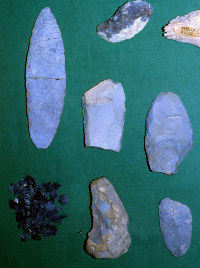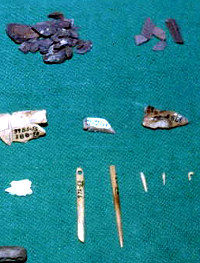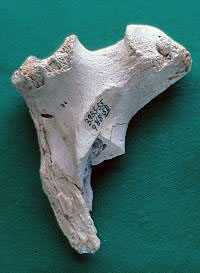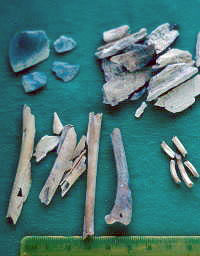
|

|
Sub-Stratum 5D: Lower member—ash lens drag down
Separated from 5C with approximately 6 inches of clean deposit, Sub-Stratum 5D marks the division between the upper and lower cave deposits. It was also capped with a red clay layer, but differs from 5B and 5C in its extent and amount of occupational debris. The occupation stratum is dark and results from a short but intense period of living. It is up to 5 inches thick in a few places, but is mostly 2 inches or less.
Almost all of the sediment from this stratum has been washed on a window screen. A variety of material was recovered including flint scrapers, gravers, a large bifacial knife, worked bone fragments, several fragments of bone needles, and pieces of modified ocher. Animal remains include bison, deer, and an enormous number of small animal bones, including rabbit, mice, rats, turtle, fish, snakes, birds, and others. Many of these were charred.
Fire hearths in this level were typical of hearths throughout the Paleoindian period represented at Horn Shelter. A fire was built directly upon the surface with no rock lining, resulting in lenses of ash from ¼ to 3 inches thick. One interesting aspect about these hearths was a kind of drag-out area to one side. This varied in size and thickness. This would invariably be full of mixed ashes and charcoal flecks, along with animal bones, all mixed together with the cave deposit. It would seem that something was being dragged out of the fire, creating the accumulation of debris. The ash and debris areas were always washed separately from other material.
Although this layer has produced much in the way of cultural debris, no dart points or fragments were found. However, remains of now-extinct bison were recovered. Based on that finding, as well as diagnostic indicators recovered from strata below and above it, Sub-Stratum 5D is Paleoindian in age. Below it (in Sub-Stratum 5a), two Folsom bases and a Suwannee-like point were found; two layers above, Brazos Fishtails (ie., San Patrice) were recovered. Technological analysis of the tools from Stratum 5D may help provide a cultural identitiy for this early deposit.

|

|